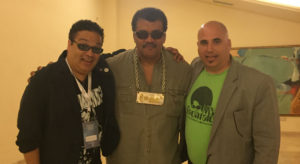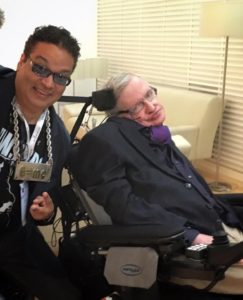By Len Pal, Clamrespondent and Co-Host of MC Hawking’s Podcore Nerdcast
Last week I wrote a piece for the Clam about Ken Lawrence’s MC Hawking project, and how it led to an invitation to perform for Stephen Hawking and over a thousand other delegates, including eleven Nobel laureates, and many of the most brilliant scientists of our time. To recap, while playing around with his computer’s text-to-speech software, Ken realized it sounded a lot like Stephen Hawking, so he used his background in musical composition to make it rap. The resulting songs got pretty popular online, Professor Hawking’s people heard and liked them, and sixteen years or so later, it led to an invitation to perform at Starmus, a prestigious conference celebrating science, music, and the arts.
So, that happened. It was pretty amazing, and I’m back to tell you about it.
Starmus was founded when Brian May went back to school to complete his PHd in astrophysics, which was on the back burner for about thirty years while he was busy with his own musical side project, a band named Queen. His thesis advisor was Dr. Garik Israelian, who also happened to be a musician. The two struck up a friendship and realized that music and science should be celebrated together. The first Starmus festival took place in 2011 with about 200 attendees. The second, in 2014, hosted nearly a thousand, and the third in 2016 had nearly 1600.
Starmus featured three days of lectures by speakers like Stephen Hawking, Neil deGrasse Tyson, Kip Thorne, Martin Rees, author and futurist Robert J. Sawyer, cyber-security expert Eugene Kaspersky, Richard Dawkins, and astronaut Chris Hadfield, to name just a few. And I’m going to be honest and admit that at times, the science was a bit over my head. But that doesn’t matter – I came away with enough of a taste for it that now, I want to keep learning more about all of it! More than that, I want to make other people want to learn about this stuff!
Like, maybe you already knew that LIGO, the Laser Interferometer Gravitational wave Observatories operated by Caltech and MIT, use intersecting laser beams two kilometers long to detect alterations in spacetime when gravitational waves pass through them. Just last month, their two observatories, located in different parts of the United States, detected gravitational waves caused by the merging of two black holes. For real, that happened.
You probably also knew that the science in the movie Interstellar was actually accurate. Astrophysicist Kip Thorne came up with the idea behind the movie, and worked closely with director Christopher Nolan (as well as his special effects team) to make a science fiction movie about black holes that actually got it right, both in terms of the plot and in the visualizations. Top of my to-do list now that I’m home is to watch the movie again with a greater appreciation for what I’m looking at.
I could write pages and pages about the different amazing lectures, but I won’t. (You’re welcome.) Honestly, there was just too much and I’m sure I’d get the science wrong anyway. Suffice it to say that every speaker made me want to run out and buy ten books about whichever topic they were presenting.
The trip was not without drama. On Wednesday, we arrived at the conference venue several hours early to have a tech rehearsal for Ken’s performance, but security wouldn’t let anyone in the building. We finally managed to text someone with enough clout to come get us. After the rehearsal, we ran into Deborah, Stephen Hawking’s personal assistant (whose idea it was to have Ken bring an MC Hawking performance to Starmus). She informed us that earlier in the day, Stephen’s daughter alerted the police to a number of e-mails and tweets the professor was receiving from a woman who said she was nearby in Tenerife, planning to kill him. Deborah seemed mostly unfazed, telling us that Stephen gets “stuff like that all the time”, but that they still have to take it seriously, which is why security was heightened for the rest of the week. We later found out that the woman, an American who appeared to be both a religious fanatic and mentally ill, really was attending the conference and staying in a nearby hotel. They arrested her and found the professor’s itinerary along with detailed plans for his murder in her possession.
Ken started his performance with a brief speech introducing himself and how he came to be known as “MC Hawking”, and then showed a seven minute mockumentary entitled MC Hawking: A Brief History of Rhyme, narrated by voice actor Dave B. Mitchell. The film provided a fictional biography of Stephen Hawking’s origins as a gangster rapper, until a scientific breakthrough tragically pulled him away from rapping and back into theoretical astrophysics. Within the film, scientists were shown with their faces blurred and their names changed to protect their identity, but the crowd roared with laughter to see Dr. Harick Gisralean, Dr. Feel the Grass Bison, and Dr. Myron Bay (Garik Israelian, Neil deGrasse Tyson, and Brian May, respectively) tell stories about Stephen Hawking as a rapper.
Ken, MC Lars, and I were backstage, nervously awaiting the crowd’s reaction while watching the film in reverse on the back of a large projection screen. Ken said “if we get some laughs at the first joke, we’re okay”. Our worst fear was that the crowd would be offended by the idea of the professor as a trash-talking, bling-wearing, gangster rapper. But even just thirty seconds into the mockumentary, the crowd was hysterical.
When the film ended, a backing music video started playing the first verse of the MC Hawking song, a brand-new track entitled Fear of a Black Hole. The “Stephen Hawking” voice sang the first verse, and then Ken and MC Lars went on stage to sing the chorus. Lars sang the next verse, backed up by Ken, followed by another chorus, and then I handed Ken his guitar for a solo.
I need to give Ken props here. Any musician might feel intimidated performing in front of a fairly large audience. Probably even more so performing in front of an audience that included the world’s foremost scientists and astrophysicists, as well as some Nobel Prize winners and at least eight or ten people who have spent time away from Earth. But Ken had to contend with all of that in addition to seeing Brian May, one of the greatest guitarists of all time, staring up at him from the front row. Ken told me later that at one point he looked down and saw Brian smiling at him and bobbing his head to the music, and he had to look away, or else he might forget to keep playing.
After the guitar solo, Ken and MC Lars finished with another chorus, during which Lars shouted “Get your black holes in the air!” The crowd as one all threw up a hand gesture mirroring the one Lars and Ken were doing, of a hole made by thumb and forefinger, pumping to the beat. From behind the stage curtain, I watched Brian May gesturing along with everyone else. Mind blown.
After the performance on Wednesday, all of the pressure was off and we could just have fun. We didn’t have to point at Ken’s conference badge to get into the VIP areas anymore; now everyone knew who we were. The lecture series ended on Wednesday, so we took Thursday off to snorkel with some sea turtles. Around the hotel, we hung out with scientists and celebrities.
On Friday, the conference moved to an auditorium about an hour north for the six-hour Sonic Universe concert. For the first hour or so, Hans Zimmer conducted an orchestra while Sarah Brightman sang. Rick Wakeman played piano while astronaut Chris Hadfield played guitar and sang David Bowie’s Space Oddity, just like he did on the International Space Station. Rick Wakeman then played Bowie’s Life on Mars on piano. Anathema played about an hour-long set, with Stephen Hawking on stage with them to provide narration during their first song, and eventually ending with Queen’s Who Wants to Live Forever. A pretty ballsy song choice actually, with Brian May sitting in the front row. During the intermission, Ken got to spend a few minutes with Professor Hawking.
At the start of the final segment of the concert, astrophysicist Kip Thorne took the stage and briefly explained how he came up with the idea for the movie Interstellar, and how he worked closely with director Christopher Nolan and his team to create a science fiction movie that actually got the science part right. Effects artists Paul Franklin and Oliver James then explained how they took Kip’s direction and created visualizations for the film that showed what a black hole really would look like up close. This would have felt out-of-place in any other concert, but especially after a week of scientific lectures, nobody fidgeted in their seats.
The point of the lecture was to explain the visualizations that were shown next. Hans Zimmer returned to the stage with a couple of guitarists, a violinist, and a string quartet. He played a keyboard along with the musicians in a band he called “Kip Thorne and the Black Holes” while beautiful (and scientifically accurate) visualizations of black holes and neutron stars played on the screen behind them.
Nothing I’ve written or could write would do justice to the amazing experience I’ve had over the last week. I’m at nearly 1600 words and I feel like I haven’t scratched the surface. Back here in the “real world”, there are people who don’t believe in climate change or vaccinating their kids, let alone show any real interest in the science that is all around us. I’m starved for it now, and you should be too.
I’ll leave you with this challenge. This summer, go to the Museum of Science. Read Bang! The Complete History of the Universe or A Brief History of Time. Watch Cosmos: A Spacetime Oddessy, and also watch Interstellar. You see where I’m going with this, right? Get out there and learn something.






